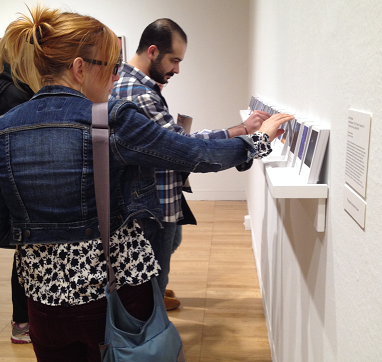On Thursday, January 28th, the Krannert Art Museum (KAM) held an opening reception for their Spring 2016 exhibition season. Showcasing all four of their exhibitions opening on the same night, the evening proved exciting with the possibilities of interaction and exploration.
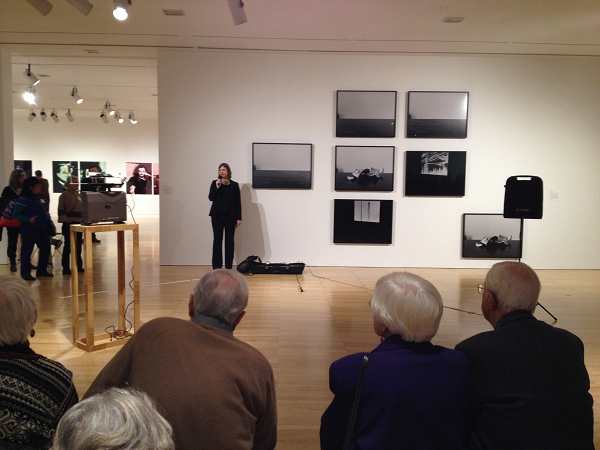
Following a well-attended members-only reception, the general public gathered in the East Gallery with museum members, KAM staff, university faculty, and students. KAM’s Director Kathleen Harleman greeted the large crowd of guests to the museum and the opening reception before offering a brief introduction of Curator of 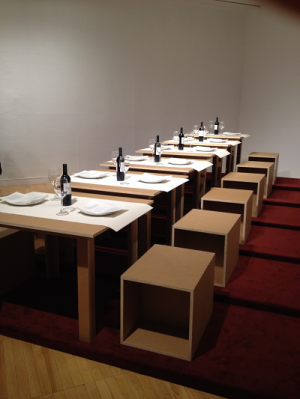 Contemporary and Modern Art Amy L. Powell. Also as the curator of Time / Image, Powell spoke about the concept behind the exhibition and how a few of the surrounding pieces highlighted the exhibit’s concept. She mentioned a number of events tied to the exhibition including Time Symposium (2011-the present) by the Raqs Media Collective. Abbreviated from “rarely asked questions” and pronounced “rux,” Raqs will be inviting twelve people from various University of Illinois departments to discuss time in a Greek symposium-like performance piece. As Powell and other media sources have noted, Time Symposium on Thurs. Feb. 25th will be the work’s first U.S. museum iteration. She didn’t comment on how much effort she has put into this endeavor, but her work to gather together the international artists and works is evident. Since 2014 she has worked with the Blaffer Art Museum at the University of Houston, the Raqs Media Collective, and the Krannert Art Museum to bring Time / Image to fruition.
Contemporary and Modern Art Amy L. Powell. Also as the curator of Time / Image, Powell spoke about the concept behind the exhibition and how a few of the surrounding pieces highlighted the exhibit’s concept. She mentioned a number of events tied to the exhibition including Time Symposium (2011-the present) by the Raqs Media Collective. Abbreviated from “rarely asked questions” and pronounced “rux,” Raqs will be inviting twelve people from various University of Illinois departments to discuss time in a Greek symposium-like performance piece. As Powell and other media sources have noted, Time Symposium on Thurs. Feb. 25th will be the work’s first U.S. museum iteration. She didn’t comment on how much effort she has put into this endeavor, but her work to gather together the international artists and works is evident. Since 2014 she has worked with the Blaffer Art Museum at the University of Houston, the Raqs Media Collective, and the Krannert Art Museum to bring Time / Image to fruition.
Visitors were then encouraged to explore the four new exhibitions for Spring 2016. While they vary greatly in concept and focus, the exhibitions do seem to have some commonalities. Time / Image (on exhibit from Jan. 29th to Apr. 23rd) focuses on the deep relationship between contemporary art and modern cinema.
Collage: Moving Beyond Paper (on exhibit from Jan. 29th to Mar. 26th) focuses on the evolution of collage and assemblage from its roots in early Modernism. Spheres of Influence: African Vessels from the KAM and Spurlock Collections (on exhibit from Jan. 29th to May 15th) showcases the craftsmanship of utilitarian and aesthetically pleasing ceramic vessels from Africa. Collecting Photography (on exhibit from Jan. 29th to Mar. 26th) features a variety of photographic depictions of cultural, political, and social issues from works recently acquired by the museum. All in all, the four exhibitions offer something for everyone to explore.
In the East Gallery, Time / Image derives its concept and theme from French philosopher Gilles Deleuze. His concept of “time-image” in post-World War II cinema (and especially French cinema) has been a common topic for contemporary artists to engage with and manipulate. For example, Simeon Allen’s Screen II (2015; edited from four panels to one) uses VHS tape, a medium which used in its intended form can capture both image and sound. Woven onto a steel frame, the magnetic tape creates a blurry, mirror-like surface. The VHS tape in Screen II is incapable of capturing the moving images across its surface even though the medium itself is designed to do so. Other works in the exhibition use 16mm film on an endless loop, take-away postcards of ephemeral moments in time, and video installations to deconstruct and reconstruct our notion of what makes up time. In addition to the exhibitions, KAM will be having an artist talk by Raqs entitled “Untimely Calendar” on Wednesday, February 24th along with Time Symposium on Thursday, February 25th. KAM also will be co-hosting a film series centered around French cinema at the Art Theatre Co-Op in early March.
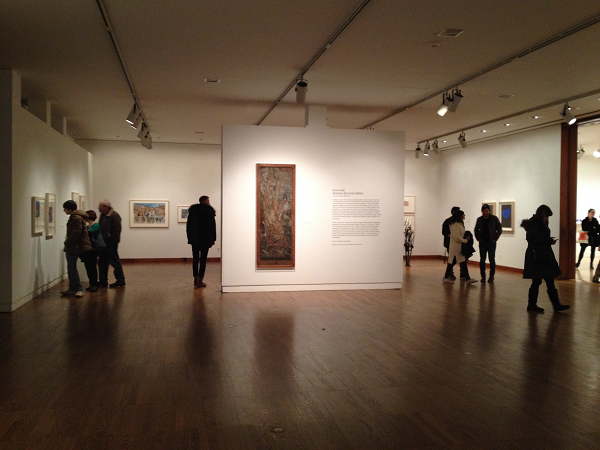 In the Rosann Gelvin Noel Gallery, Collage: Moving Beyond Paper by assistant curator Kathryn Koca Polite showcases the shift from collage as papiers collés to assemblage (or three-dimensional artworks) to something more complex. The exhibit offers a diverse selection of artworks that challenge the binary notion of two- and three-dimensions. Jenni Lukac’s Talitha Cumi (1992) is a good example of this shift. A small book, obviously a religious text, has had a space carved out of it to make room for two glass vials with ash inside them. On the facing page, more pages are carved out to let a cyanotype print of a woman’s portrait to emerge from the printed pages. The manipulation of materials to create something new and meaningful, to add an extra layer of introspection, is evident throughout the exhibition. For me, Willie Cole’s Work Animal II (2014) and its contemporary bicycle parts to refer to the mythical creature called chi wara. The work conjures up thoughts about transportation, physical labor, and mythologies in interesting ways. With a variety of pieces from the late 20th to the early 21st century, Collage offers a great sample of pieces from KAM’s collection.
In the Rosann Gelvin Noel Gallery, Collage: Moving Beyond Paper by assistant curator Kathryn Koca Polite showcases the shift from collage as papiers collés to assemblage (or three-dimensional artworks) to something more complex. The exhibit offers a diverse selection of artworks that challenge the binary notion of two- and three-dimensions. Jenni Lukac’s Talitha Cumi (1992) is a good example of this shift. A small book, obviously a religious text, has had a space carved out of it to make room for two glass vials with ash inside them. On the facing page, more pages are carved out to let a cyanotype print of a woman’s portrait to emerge from the printed pages. The manipulation of materials to create something new and meaningful, to add an extra layer of introspection, is evident throughout the exhibition. For me, Willie Cole’s Work Animal II (2014) and its contemporary bicycle parts to refer to the mythical creature called chi wara. The work conjures up thoughts about transportation, physical labor, and mythologies in interesting ways. With a variety of pieces from the late 20th to the early 21st century, Collage offers a great sample of pieces from KAM’s collection.
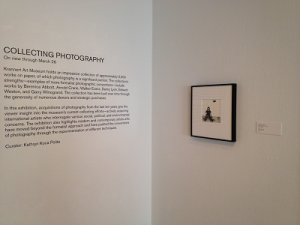 Also curated by Polite, Collecting Photography offers photographs acquired by the museum in the past ten years. The exhibition may be the least interactive and engaging of the four exhibitions with photographs simply hung around the room. With a few exceptions, there is nowhere to sit in KAM so you are constantly on your feet. As someone who enjoys spending time with a work of art, it’s a little sad I wasn’t given the chance to sit and reflect upon a work that interested me. However, Collecting Photography highlights the museum’s mission objectives to collect artworks discussing cultural, political, and social issues. All of the works, in one way or another, focus on one of these main objectives. When compared to the other exhibits, Collecting Photography could use a push to be either more interactive or engaging with visitors.
Also curated by Polite, Collecting Photography offers photographs acquired by the museum in the past ten years. The exhibition may be the least interactive and engaging of the four exhibitions with photographs simply hung around the room. With a few exceptions, there is nowhere to sit in KAM so you are constantly on your feet. As someone who enjoys spending time with a work of art, it’s a little sad I wasn’t given the chance to sit and reflect upon a work that interested me. However, Collecting Photography highlights the museum’s mission objectives to collect artworks discussing cultural, political, and social issues. All of the works, in one way or another, focus on one of these main objectives. When compared to the other exhibits, Collecting Photography could use a push to be either more interactive or engaging with visitors.
Senior Curator and Curator of African Art, Allyson Purpura, clearly emphasizes an artist’s ability to craft and manipulate a material by hand in the exhibition Spheres of Influence: African Vessels from the KAM and Spurlock Collections in the Asian Gallery. Here 24 ceramic urns, vases, and large pots from African craftswomen show the various techniques of making a vessel. The beauty of this exhibition is in the presentation of the vessels. A separate handout next to the exhibit’s main didactic gives background information on each individual object while numbers are used to denote one vessel from another on their platform. This approach allows for visitors to admire the vessels from an aesthetic point of view first and then seek out more information. Also, the opportunity to see almost all of the vessels without a vitrine between you and object is wonderful for really looking at one (or all) of them. Excerpts from the film African Pottery Techniques (2001-2002; produced by professor Christopher Roy from the University of Iowa) can be softly heard in the gallery. The film explains the different techniques used by the predominantly female artisans to make the designs on a particular vessel. From Spheres, visitors can walk through to the African Gallery to further explore African art and culture within Encounters: The Arts of Africa, the award-winning exhibition on continuous display.
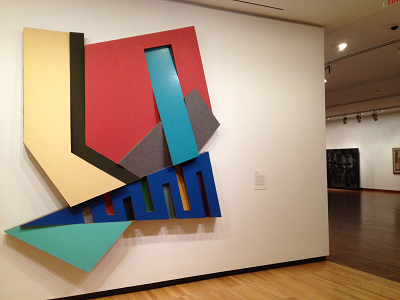
Before leaving the museum, however, I spent some time with the recently conserved Kozangrodek III (1973) by Frank Stella. As part of Stella’s Polish Village Series (1970-1974), Kozangrodek III refers to multiple points in time. The vibrant colors are reminiscent of stained glass windows like those in the Polish synagogues built between the 17th and 19th centuries in Poland that inspired the series. The sharp angles, however, possibly refer to the destruction of those places of worship during the Nazi occupation of Poland before and during World War II. As an assemblage piece of mixed media, Kozangrodek III easily fits into the Collage exhibition it is a part of, but it seems to transcend such an easy categorization. Stella’s work serves as a segue between the places in the past where we have just been, where we are in the present, and the places in the future that we will soon be exploring.
All four exhibitions at the Krannert Art Museum offer something for the modern and contemporary art fan. Central themes of materiality, aesthetic manipulation, and evolving art forms run strongly between Time / Image, Spheres of Influence, Collage, and Collecting Photography. Even though they are uniquely different based on concept, the exhibitions flow nicely from one to the other without feeling disjointed or unrelated. If you can, take some time out of your day to visit KAM and find a favorite piece to experience for yourself.
The Krannert Art Museum’s hours are Monday to Friday from 9 a.m. to 5 p.m. with extended hours on Thursdays to 9 p.m. Admission is free, but a suggested donation of $3 is appreciated. More information can be found at the museum’s website.
For more information on the Time / Image film series to be held at the Art Theatre Co-Op in March, check the Art Theatre’s “Coming Soon” page for details.
All photos by Sarah Keim with permission of the museum.








